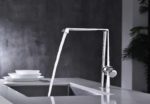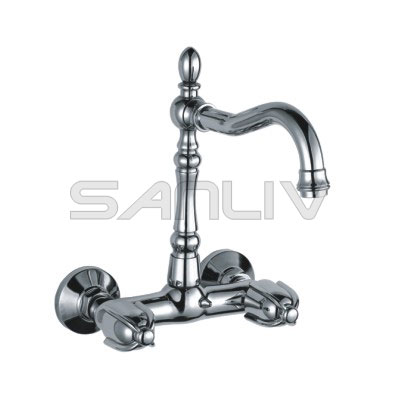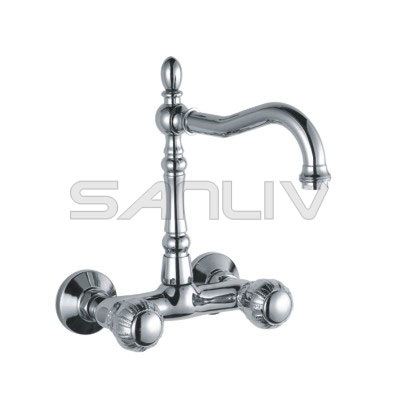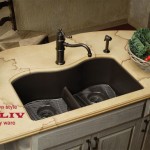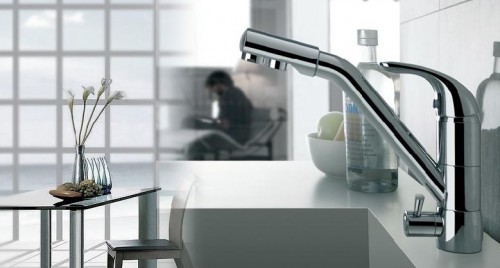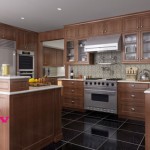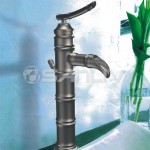Professional tips on how to choose a kitchen faucet. Taking a look at some basic considerations you should think of when choosing kitchen faucets.
* Choose A Faucet And Sink Together (When Possible)
Choosing a faucet and sink together can avoid potential problems that could arise if the two decisions are made independently. Foremost is the fact that the sink needs to have sufficient holes to accommodate the faucet configuration you choose. By the same token, your countertop will need to match as well, if your faucet will be mounted on the countertop surface.
If you’re just buying a new faucet, then your options will be limited by your existing sink configuration.
Bottom line – choose a faucet and sink that will work together in order to avoid headaches and product returns later on.
* Single Lever Faucets Offer Several Conveniences
Single lever faucets leave one hand free to hold dishes, food or whatever, while the other adjusts the water control. Two-handled faucets require you to use both hands to turn on the water and regulate temperature (or use one hand to operate one handle, then the other).
Fewer requirements for faucet holes (as with a single-handle faucet) also mean fewer holes to be drilled in a countertop, making for a slightly easier and cheaper countertop installation, particularly if your countertops are stone.
* Choose A Faucet Size That Complements Your Sink
The size of your kitchen faucet should be in proportion to the size of your sink. A large faucet will tend to overpower a small sink while the reverse is true when a small faucet is used with a large, three-bowl sink (not to mention the fact that the faucet might not have adequate reach over a big sink). Which brings us to….
* Make Sure The Faucet Has Adequate ‘Reach’
The faucet you choose should sufficiently cover your sink, meaning that it can swing in an arc large enough to dispense water to a good portion of the sink’s basin(s). The faucet’s reach is determined by the horizontal distance from the spout opening to where it connects to the sink or countertop.
This really isn’t a problem with pull-out and pull-down faucets since these features effectively increase the range of where the water can be delivered.
* Choose Your Faucet Before Your Countertops (Where Possible)

Custom countertops require the knowledge of how many holes your faucet configuration needs ahead of time. That doesn’t mean extra holes can’t be drilled after the countertops are installed but it may require more hassle and cost than if they’re made and installed pre-drilled for the kind of faucet you’ll install.
* Colored Faucets May Be Plastic
If you’re browsing colored faucets, keep in mind that some may be made out of plastic. That’s OK if you’re OK with it. But if you’re looking for longevity, choosing a faucet made from steel or cast brass will be your best option. Sometimes it’s not explicitly clear whether a colored faucet is plastic or metal. Make sure you read the accompanying descriptive information carefully to know for sure.
* ADA Compliant Faucets
Faucets that comply with the ADA (Americans with Disabilities Act) are typically marked as such. These faucets comply with the ADA Accessibility Guidelines (4.27.4) that specify the requirements for controls and operating mechanisms. In other words, the faucet must be operable with one hand and cannot require tight grasping, pinching or twisting of the wrist and must be operable with a force no greater than 5 pounds.
* Know/Understand Delivery “Lead Times”
Unless you choose a faucet off the shelf, the faucet you want may have a ‘lead time’ which is the time it takes between actually ordering it and getting it in your hands. This is true both when ordering online and sometimes through a bricks-and-mortar supplier. Keep this in mind relative to the timing of other facets of a kitchen remodel so the faucet won’t be holding up any aspect of the project.
* Getting A Feel For The Faucet
Getting to know the feel of operation of various kitchen faucet configurations can help with the selection process. That doesn’t mean you necessarily have to feel every type you’re interested in. But understanding that you prefer single lever faucets with larger, more rounded handles vs. smaller handles that can poke you will help you gain long term satisfaction with your purchase.
Choose the best Faucet Handle Might Feel Better To You.
Personally, I’ve never been fond of the kind of cartridge faucets where you have to pull the lever up to turn the water on and then swing it from side to side to regulate temperature. I find the “pulling up” motion takes more effort than a “push” motion used with other types of single-handle faucets. Sometimes it just takes your own experience from using your friends’ faucets or fixtures at hotels and other establishments to know what feels right and what doesn’t.
Taking the time to “test drive” a few faucet varieties can help you narrow your choices and ultimately end up with a faucet that provides you with satisfaction and good service.

